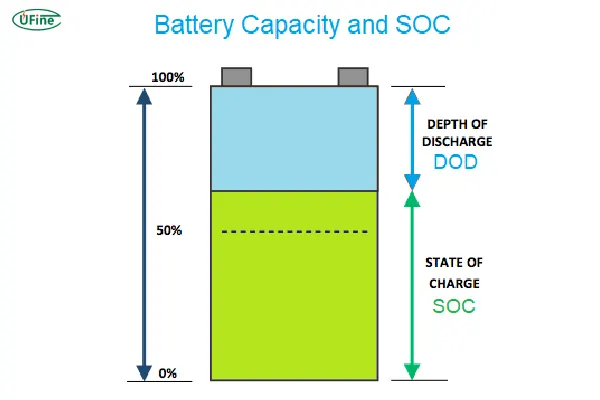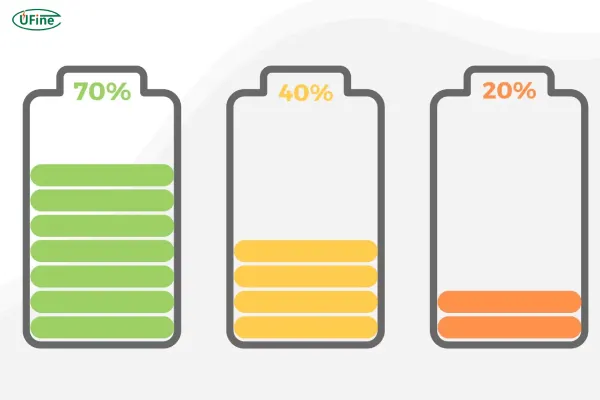
- Part 1. Understanding state of charge (SoC)
- Part 2. Advanced methods for SoC estimation
- Part 3. Factors influencing SoC estimation accuracy
- Part 4. Practical guidelines for measuring SoC accurately
- Part 5. Detailed breakdown of SoC estimation methods and real-world applications
- Part 6. Combining methods for maximum accuracy
- Part 7. Future trends in SoC measurement
- Part 8. Conclusion
Accurately determining a battery’s State of Charge (SoC) is essential for optimizing performance, ensuring safety, and extending lifespan across various applications, from consumer electronics to electric vehicles (EVs). This comprehensive guide delves into advanced methodologies for measuring SoC, providing a detailed analysis suitable for professionals and enthusiasts seeking in-depth understanding.
Part 1. Understanding state of charge (SoC)
The State of Charge (SoC) represents the current capacity of a battery as a percentage of its maximum capacity. It’s a dynamic parameter, influenced by factors such as discharge/charge rates, temperature, and battery aging. Accurate SoC estimation is pivotal for:
-
Performance Optimization: Ensuring devices operate within optimal parameters to prevent unexpected shutdowns.
-
Safety Assurance: Preventing overcharging and deep discharging, which can lead to thermal runaway or battery degradation.
-
Battery Longevity: Maintaining the battery within recommended charge levels to extend its usable life.
-
Range Prediction for EVs: Providing accurate information on remaining driving range, alleviating range anxiety among users.
Difference Between Percentage, Voltage, and State of Charge (SoC) of Rechargeable Battery?
Part 2. Advanced methods for SoC estimation
Several sophisticated techniques have been developed to estimate SoC with high precision. Each method has its advantages and limitations, and the choice depends on the specific application and required accuracy.
1. Open-Circuit Voltage (OCV) Method
The OCV method involves measuring the battery’s voltage in a no-load condition after a rest period, allowing the voltage to stabilize. The stabilized voltage correlates with the SoC based on the battery’s OCV-SOC characteristic curve.
-
Pros:
- Non-invasive and straightforward.
- Provides a direct relationship between voltage and SoC for certain chemistries.
-
Cons:
- Requires the battery to rest, making it unsuitable for real-time applications.
- Affected by temperature variations and battery aging.
- Not applicable to all battery chemistries, especially those with flat voltage-SOC curves.
For instance, lithium iron phosphate (LiFePO4) batteries exhibit a flat voltage profile, rendering OCV measurements less effective for SoC estimation.
2. Coulomb Counting Method
Also known as Ampere-hour (Ah) counting, this method calculates SoC by integrating the current flowing into and out of the battery over time.
-
Pros:
- Provides real-time SoC estimation.
- High accuracy over short periods.
-
Cons:
- Cumulative errors due to current sensor inaccuracies and integration drift.
- Requires an accurate initial SoC reference.
- Sensitive to temperature changes and battery aging.
Regular calibration is necessary to mitigate error accumulation, often achieved by resetting the SoC to 100% when the battery is fully charged.
3. Electrochemical Impedance Spectroscopy (EIS)
EIS measures the battery’s impedance response over a range of frequencies, providing insights into the electrochemical processes and internal states.
-
Pros:
- Offers detailed information about battery health and SoC.
- Can detect issues like capacity fade and internal resistance increase.
-
Cons:
- Requires specialized equipment and complex data analysis.
- Not suitable for real-time monitoring due to lengthy measurement times.
Recent advancements aim to integrate EIS into battery management systems (BMS) for continuous monitoring, enhancing SoC estimation accuracy.
4. Model-Based Estimation Methods
These methods employ mathematical models to simulate battery behavior, adjusting parameters in real-time to estimate SoC.
-
Pros:
- High accuracy under varying operating conditions.
- Can account for factors like temperature, aging, and load variations.
-
Cons:
- Complex implementation requiring detailed battery characterization.
- Computationally intensive, necessitating robust processing capabilities.
Common techniques include:
-
Extended Kalman Filter (EKF): Utilizes a linearized model around the current operating point to estimate SoC.
-
Unscented Kalman Filter (UKF): Employs a set of sample points to capture the true mean and covariance, improving accuracy over EKF.
-
Particle Filter: Uses a set of random samples to represent the probability distribution of the SoC, suitable for highly nonlinear systems.
These methods are particularly effective in applications like EVs, where operating conditions vary widely, and accurate SoC estimation is critical.
Part 3. Factors influencing SoC estimation accuracy
Accurate SoC estimation is challenged by various factors:
-
Temperature Variations: Affect battery voltage and internal resistance, leading to estimation errors.
-
Battery Aging: Capacity fade and increased internal resistance alter the battery’s performance characteristics.
-
Discharge Rates: High discharge rates can cause voltage drops, misleading voltage-based SoC estimations.
-
Self-Discharge: Batteries lose charge over time even when not in use, affecting SoC accuracy.
Part 4. Practical guidelines for measuring SoC accurately
To achieve the most accurate SoC measurement, consider the following best practices:
1. Choose the Right Method for Your Application
- For consumer electronics (e.g., smartphones, laptops): Use a combination of voltage-based and coulomb counting methods.
- For electric vehicles: Model-based estimation, such as the Extended Kalman Filter, is preferred due to its adaptability.
- For grid storage and industrial batteries: Electrochemical impedance spectroscopy (EIS) provides precise data on battery health and SoC.
2. Regular Calibration
To prevent SoC drift, periodically perform a full charge/discharge cycle. This helps reset estimation errors in coulomb counting methods.
3. Temperature Compensation
Implement temperature correction factors to avoid inaccuracies due to voltage fluctuations caused by environmental changes.
4. Software and Firmware Updates
Keep your battery management system updated to benefit from the latest improvements in SoC estimation algorithms.
Part 5. Detailed breakdown of SoC estimation methods and real-world applications
1. Open-Circuit Voltage (OCV) Method – Best for Standby Applications
The OCV method is widely used for estimating SoC in applications where the battery is frequently in a resting state.
Implementation:
- The battery is left idle (no charge or discharge) for a certain period.
- The terminal voltage is measured.
- The voltage is compared to an OCV-SOC reference curve (specific to battery chemistry).
Real-World Example:
- Energy Storage Systems (ESS):
Large-scale renewable energy storage systems use OCV measurement when the system is in standby mode to verify battery charge levels before dispatching power to the grid. - Backup Power Systems (UPS):
Uninterruptible Power Supplies (UPS) in data centers often use OCV estimation to check battery readiness in case of power outages.
Limitations:
- Requires a long rest period to get accurate readings.
- Not practical for dynamic applications like EVs or drones.
2. Coulomb Counting – Preferred in Consumer Electronics and Small Devices
The coulomb counting method works by integrating current flow over time, tracking charge entering and leaving the battery.
Implementation:
- A current sensor measures charge (Ah) flowing in and out.
- The accumulated charge is subtracted from or added to the last known SoC.
- Regular calibration is necessary to reset errors.
Real-World Example:
- Smartphones and Laptops:
Devices like the iPhone and MacBook use coulomb counting combined with voltage reference points to provide a battery percentage indicator. - Medical Devices:
Portable medical devices like pacemakers and insulin pumps rely on coulomb counting for accurate battery life estimation.
Limitations:
- Drift over time: Small sensor errors accumulate, requiring periodic recalibration.
- Highly dependent on accurate initial SoC setting.
3. Kalman Filter (KF) Methods – Used in Electric Vehicles (EVs)
Kalman filtering is a model-based estimation method that continuously refines the SoC prediction based on real-time voltage, current, and temperature inputs.
Types of Kalman Filters Used:
- Extended Kalman Filter (EKF) – Handles non-linear battery models.
- Unscented Kalman Filter (UKF) – More accurate for highly non-linear batteries.
- Adaptive Kalman Filter – Adjusts parameters dynamically as the battery ages.
Implementation:
- The filter starts with an initial SoC estimate.
- The system takes real-time sensor readings.
- The filter updates its prediction using a mathematical model.
- Over time, the SoC estimation self-corrects based on feedback.
Real-World Example:
- Tesla’s Battery Management System (BMS):
Tesla uses Kalman filter-based algorithms to predict SoC, accounting for variables like temperature, load, and battery degradation. This ensures accurate range estimation. - Electric Buses and Fleet Vehicles:
Companies like BYD and Proterra implement UKF-based SoC estimation to optimize fleet battery performance under variable load conditions.
Limitations:
- Computationally intensive.
- Requires high processing power (not suitable for low-cost battery applications).
4. Electrochemical Impedance Spectroscopy (EIS) – Used in High-Precision Applications
EIS is a laboratory-grade method that measures battery impedance over multiple frequencies to determine SoC.
Implementation:
- A small AC signal is applied to the battery.
- The impedance response is measured across different frequencies.
- The impedance data is mapped to an SoC reference model.
Real-World Example:
- Aerospace Applications:
NASA and satellite manufacturers use EIS for lithium-ion battery SoC estimation in spacecraft. - Grid-Scale Battery Storage:
Utilities use EIS to diagnose battery health and SoC in large-scale energy storage farms.
Limitations:
- Expensive and complex (requires specialized hardware).
- Not suitable for real-time monitoring (mostly used for battery diagnostics).
Part 6. Combining methods for maximum accuracy
No single method is perfect for all applications. Many modern systems combine multiple SoC estimation techniques to enhance accuracy.
Hybrid Approach Example – EV Battery Management
For electric vehicles, automakers use a hybrid approach:
- Coulomb counting for real-time charge tracking.
- Kalman filtering for correcting errors and adapting to conditions.
- OCV measurement during vehicle rest periods to recalibrate SoC.
This combination ensures accurate range estimation and prevents over-discharge or over-charging.
Part 7. Future trends in SoC measurement
With advancements in technology, new methods for SoC estimation are emerging:
1. AI and Machine Learning for Real-Time SoC Prediction
- Neural networks trained on massive datasets improve SoC accuracy.
- Self-learning algorithms adapt to battery aging.
- Automakers like Rivian and Lucid Motors are investing in AI-driven BMS solutions.
2. Blockchain-Based Battery Tracking
- Decentralized battery data tracking ensures secure and verifiable SoC readings.
- Used in EV fleets to optimize battery usage and resale value.
3. Quantum Battery Research
- Researchers are exploring quantum effects for near-instant SoC estimation.
- Could revolutionize energy storage and electric mobility.
Part 8. Conclusion
Measuring the State of Charge (SoC) of a battery is a critical function in modern battery management. The right method depends on the application, required accuracy, and computational resources available.
- For small devices (smartphones, laptops) → Coulomb counting is the standard.
- For electric vehicles (Tesla, Rivian, BYD) → Kalman filter methods provide precise range predictions.
- For aerospace and high-precision industries → EIS and machine learning are leading-edge technologies.
Related Tags:
More Articles

Solid State Battery vs Lithium Ion: A Comparative Analysis
Compare solid-state and lithium-ion batteries in safety, energy, charging speed, cost, and lifespan. See which works best for EVs, phones, and storage.
Learn safe LiPo battery storage tips, including charge levels, temperature, and humidity control, to extend battery life and prevent risks.
18650 Battery 4.2V VS 3.7V: What is Different?
Compare 18650 batteries: 4.2V vs 3.7V. Learn what V stands for, voltage differences, charging, applications, and which battery suits your device.
How Long Do Rechargeable AA Batteries Last?
Rechargeable AA batteries last 2–10 years (500–2000 cycles). Compare NiMH vs Lithium, tips to extend life, and when to replace batteries.
Industrial Battery vs. Regular Battery: A Complete Comparison
Compare industrial vs regular batteries by lifespan, performance, and cost. Learn which type suits forklifts, solar systems, tools, or common household devices.




